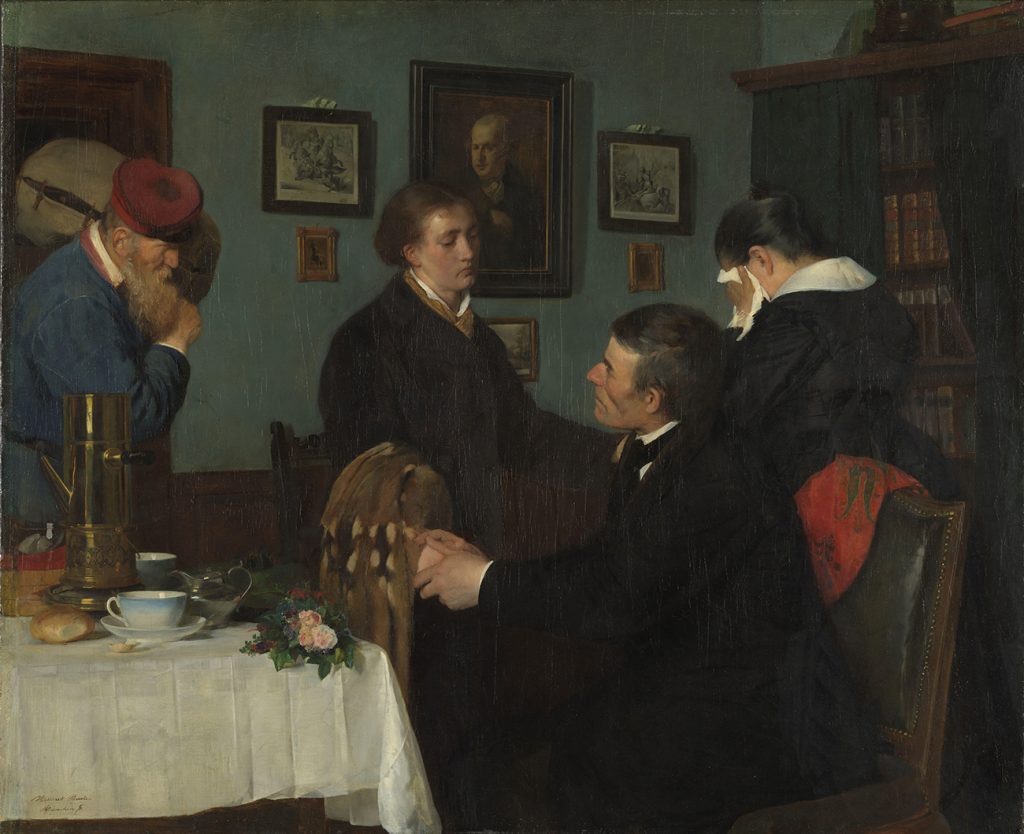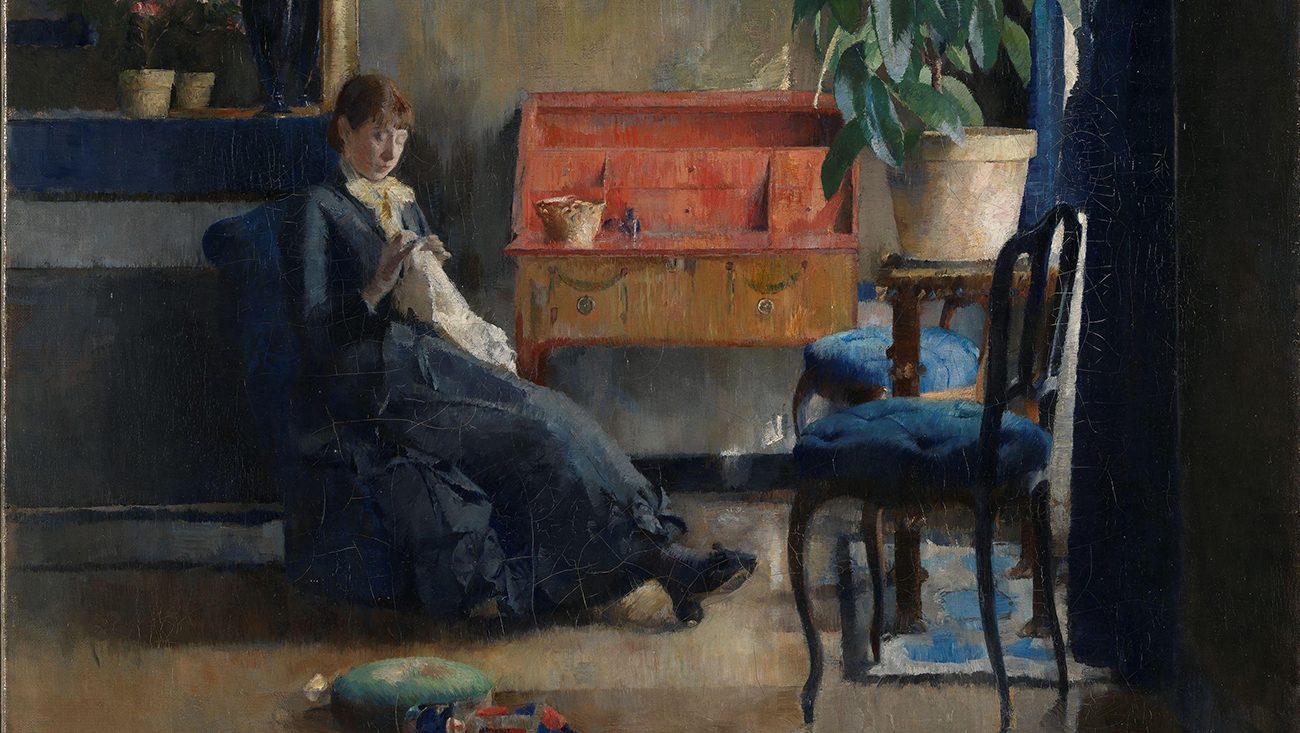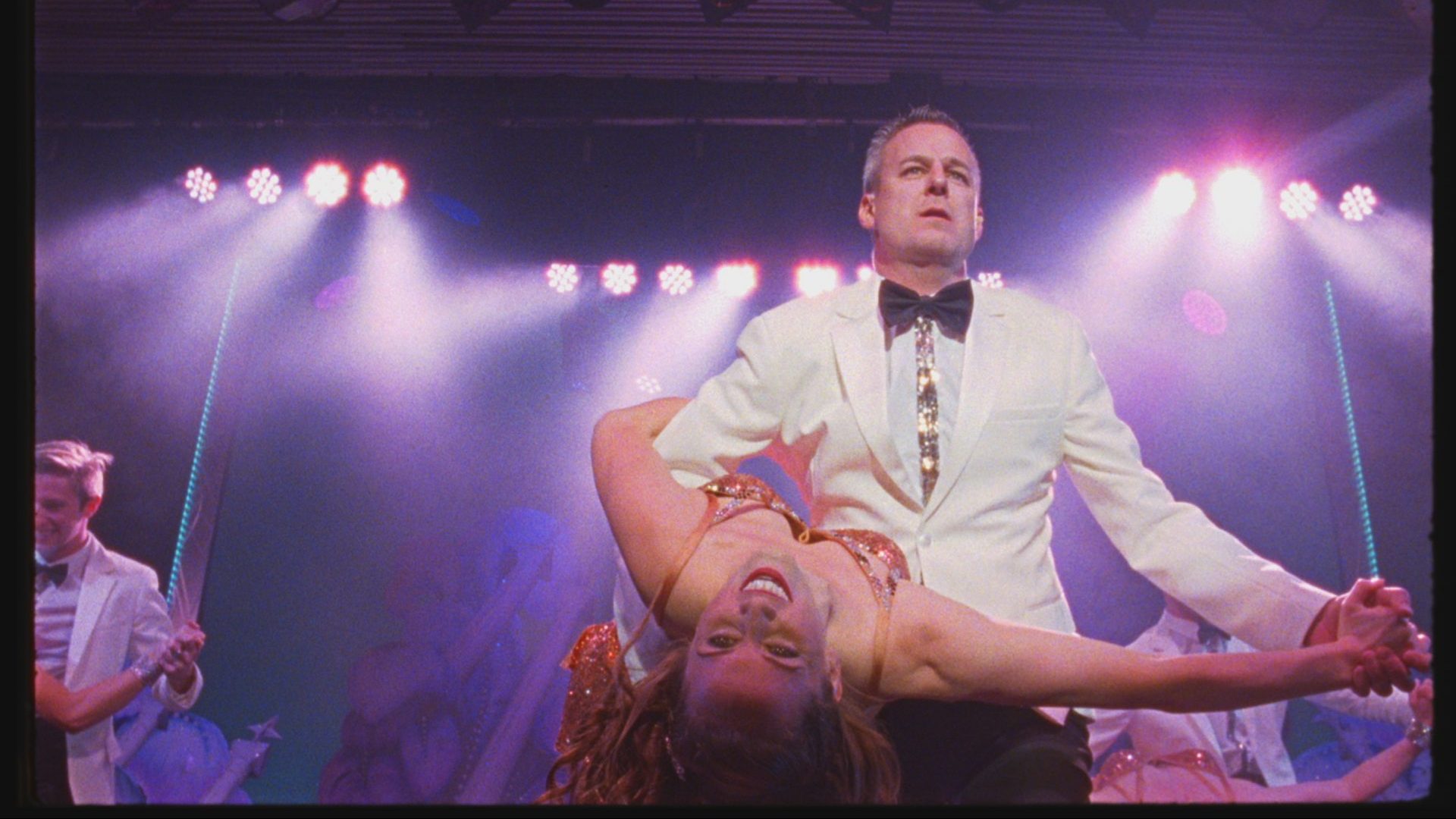A terrible row broke out over dinner one evening in May 1887. Among the Nordic expat painters of Paris, conversation had turned to a new exhibition by that “insane impressionist” Monet, and Hildegard Thorrell, a Swedish painter and enthusiastic letter-writer, recorded the uproar. The Norwegians Asta Nørregaard and Harriet Backer exchanged views, Nørregaard calling Monet’s pictures “extravagant”; “Miss B”, wrote Thorrell, “in return hurled the sharpest and nastiest words in Asta’s face, who was horrified to hear her explain that it might as well be over between them.”
In a major exhibition at the National Museum, Oslo, Harriet Backer’s circle of friends, colleagues and sparring partners is as vividly presented as her commitment to Impressionist principles. Featuring some 80 paintings and drawings, Every Atom is Colour takes as its title from the Norwegian art historian Andreas Aubert’s response to Backer’s Blue Interior, 1883, a picture that the painter Eilif Peterssen said “caused a stir among the younger generation – but the older set could do without that kind of art.”
The exhibition is a collaboration between the National Museum and Kode Art Museums and Composer Homes, Bergen. It travels to Stockholm in the new year, and then to the Musée d’Orsay, before returning to Norway via Bergen in spring 2025. It’s a significant moment for an artist whose work has not been seen on any scale for almost 30 years, though Per Hedström, acting director of the National Museum, Stockholm, is clear that she has never been forgotten. Instead, he writes in his introduction to the exhibition catalogue, “In Norway, she has continued to be held in great esteem ever since her breakthrough in the 1880s.”
This is more than a platitude: Backer not only won the high opinion of male and female peers early on, but was regularly and publicly honoured, described by the Swedish art historian Carl G Laurin as “one of contemporary Europe’s greatest realist artists.” In 1889, her painting Chez Moi was acquired by Norway’s National Gallery, and for 20 years she sat on the Gallery’s acquisitions committee and board of directors. Even so, Backer has remained almost unknown outside Scandinavia, and the exhibition’s stop in Paris will reintroduce her to the city where she made her name, and lived for 10 years.
Backer’s affinity with music, her understanding of light and colour, and her wish to represent something of female experience, recur again and again, and curator Vibeke Waallann Hansen shows that, like so many artists, Backer’s trajectory was not linear, but turned on particular motifs and interests.
Backer was 29 by the time she made the earliest works here, having spent the best part of a decade touring Europe with her sister, the pianist and composer Agathe Backer Grøndahl. It was only on her return to Norway that she turned her attention fully to her own prospects. “There was no longer any doubt in my mind about what I wanted in life, I wanted to be a painter”, she wrote some years later. For Harriet, just as had been the case for her sister, this meant leaving Norway.
Today, we tend to think of Paris as the sole destination for aspiring artists in the 19th century, but from the 1870s, Munich was a popular choice for foreign students, particularly Scandinavians. According to Backer’s contemporary, the British artist Charlotte J Weeks, women were “drawn as by magnetism, to Munich, all agreeing that in this place they found their various requirements met”.
So it was that in 1874, Harriet Backer moved to Munich, drawn by its thriving art scene, plentiful opportunities to exhibit and sell work, and the freedom to lead a “garçon life”, largely untroubled by the restrictions imposed on middle-class women elsewhere.
Still, women were decades away from enjoying the same experience as their male colleagues, and as elsewhere in Europe, they were not admitted to the official academy. Backer’s 1875 drawing of a male nude shows the quality of education she was able to receive even so: she was one of a group of women who clubbed together to organise studio space, models and tuition.
Later, Backer described these years in Munich as “probably the happiest time in my life”, and it was here that she made her most important and enduring friendships, including with Eilif Peterssen, mentor to Backer and Asta Nørregaard, and the landscape painter Kitty Kielland, who would become her lifelong companion.
The earliest pictures here are narrative scenes in domestic interiors, but in fact, Backer resolved to be a portraitist when she arrived in Munich. Later in the show, examples of her portraits of friends, including of Kitty Kielland in 1883, show her considerable abilities in that field, but in an interview in 1892, she described the special pull of interiors: “As soon as I enter somewhere that has farmhouse furniture or glossy walls in blue and red tones, where the light from the trees and sky outside is reflected in through the window or open door, I find myself standing in front of a canvas painting and saying to myself: Here we go again.”
When her father died in 1877, Backer had to support herself and sold narrative scenes often with a historical or literary theme such as In the Servants’ Quarters, 1877, and the fictional portrait A Scholar, heavily influenced by her studies of Old Master paintings, but also surely by Degas and Cézanne.

She marked the end of her time in Munich with The Farewell, 1878, a depiction of a young woman taking leave of her parents. The painting is the artist’s shop window, and though our attention is drawn to the emotional interactions of the four figures dominating the space, she has made sure to include a gorgeous still life, of a cloth-covered table laid with a large brass coffee pot, cups and saucers, bread and roses. The Farewell won Backer a free place at the Académie Trélat, where she took lessons from Léon Bonnat, who a few years later would teach Edvard Munch, and Jean-Léon Gérôme.
Unlike Backer’s previous narrative scenes, the contemporary setting of The Farewell clearly aligned her with the Impressionists, whose influence she would fully absorb in Paris. But rather than undergoing a wholesale transformation of style, Backer’s early successes at the Paris Salon were the sorts of historical interiors she had been making in Munich, owing more than a little to Dutch 17th-century paintings of everyday life.
But while neither Solitude, 1878-80, nor Andante, 1881, are remotely Impressionist, both contain elements of her mature style, such as the strong lighting, and emphasis on the room more than the person in it. In Solitude, the female figure was only included at all because Léon Bonnat advised Backer that the addition would meet with the approval of the Salon jury. The musical theme of Andante recurs throughout Backer’s paintings, and decades later its female figure in red finds an echo in At Great-Grandmother’s Piano, 1921.
Harriet was the least musical of the four Backer sisters, but still an accomplished pianist, who wrote that “nothing in the whole world has given me as much pleasure as music, and I have always considered it the highest of all art forms.” A piano was one of the first pieces of furniture to be installed in the Paris flat she shared with Kitty Kielland, and curator Tove Haugsbø describes Backer’s Parisian circles as “awash with music”. There’s a hint of this in her 1887 painting Chez Moi, in which a woman at the piano is joined by at least one other musician, whose presence is indicated by an empty violin case.
In Backer’s most confident and accomplished paintings, she creates a total effect, drawing the viewer into a sensuous experience, in which music is an intangible, and yet discernible element. Writing in 1924, a decade before her death, Backer placed music at the heart of her artistic project:
“It is my experience that by focusing on the study of light and rigorous drawing, one is inspired and finds the colour, receives it like a gift. I believe that the colour motifs in my pictures were only made possible by the Impressionist style. With strict composition, every speck of colour in the right place. In an unflattering constellation, they shall stand, those specks of colour, like the stars in the sky stand in their stellar constellations and wave at each other. Like musical chords sounding in perfect harmony in a colouristic interaction.”
This parallel between colour combinations and musical chords becomes increasingly evident in later interiors, which tend to be more loosely painted, with the effects of light translating into clear areas of pure colour that from a distance read as abstractions, as in the blocks of red, blue and green in Woman Sewing, 1890, or the red, green and blue of her portrait of Vedastine Aubert, c1910.
Blue Interior, 1883, marks her most pronounced shift in style, and it’s notable that while it was lauded as new and radical, the “small, rather lavender blue” interior was compared by one critic to the 17th-century Dutch master Vermeer. Though it is not a musical scene, it is similarly concerned with the intangible, its subject less the seated woman – who happens to be her friend Asta, with whom she would later argue about Monet – and more the particular mood and atmosphere of the space she occupies. This is expressed principally through the effects of light that create a kaleidoscope of patterns and juxtapositions of colour and tone, that seem to be as psychological as they are visual. Curator Vibeke Waallann Hansen points out that the back wall, the floor and even the ceiling provide expanses for colouristic experimentation, while the distribution of red, yellow, green and blue across the canvas create colour harmonies that once again suggest music.
In fact, these chord-like flourishes of red, blue and yellow occur regularly in her work, even in her “old painting” Solitude, 1880, where a reflection in the mirror, and a pile of books on the windowsill lift the monochrome gloom, indicating to the viewer the rather modern idea that this canvas can be read not just as a representation of objective reality, but as an entirely abstract colour composition.
For all her modernism, Backer never strayed far from the Old Masters. Like Rembrandt, Backer was fascinated by the effects of different light sources, and though her scenes are usually lit by an open window, she enjoyed experimenting with candle and lamp light, often diffused through a shade, or curtains, Evening, Interior, 1896, for example, allowing a glorious and virtuosic play between luminous green and orange.
Like many avant-garde painters, Backer was interested in working people, though her particular focus on women absorbed in a task, or in family groups, chimes with her involvement in the women’s movement. Still, her principal interest is always in the general environment, the atmosphere, and the intangible elements of a space. This becomes still more evident following her return to Norway in 1888, when her rustic interiors show her clearly captivated by the enveloping warm light of traditional wooden houses. Her discovery of the vibrantly coloured interior of Uvdal stave church similarly captured her imagination, and she dedicated a long series of paintings to this vestige of medieval Norway.
The vibrant still lifes of the final rooms, with their fragments of sculpture and recurring props seem to pay tribute to the painting school founded by Backer in 1891, the main art school in Norway for almost 20 years, until the Academy of Fine Arts in Oslo opened in 1909. Here, she taught pupils including Nikolai Astrup and Harald Sohlberg, artists who in recent years have introduced UK audiences to Norwegian painters beyond Munch. Both had highly idiosyncratic styles, but they owe their flair for colour to their first teacher, Harriet Backer.
Harriet Backer: Every Atom is Colour is at the National Museum, Oslo, until January 14 2024, then the National Museum, Stockholm, and the Musée d’Orsay, Paris. The exhibition’s last stop is Kode in Bergen, spring 2025




